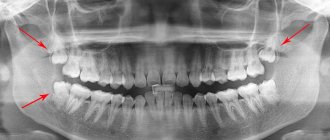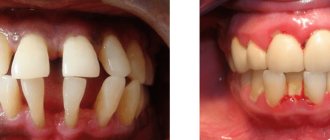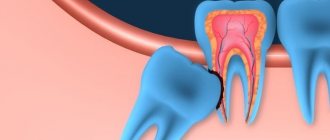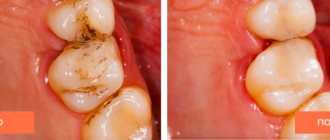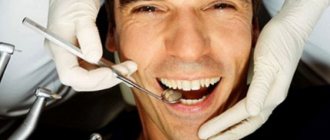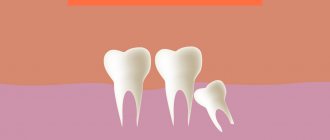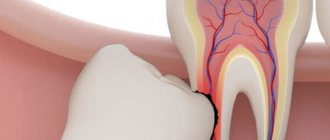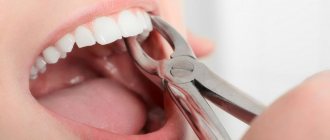Wisdom teeth, also called figure eights, often contribute to the development of dental defects. Therefore, sometimes situations arise when it is necessary to remove them. But such a procedure is quite traumatic. Before a specialist approves the removal of wisdom teeth, he weighs all the pros and cons and only then makes a final decision.
The condition of each patient’s wisdom teeth is carefully examined by the doctor, and a decision is made in each individual case only on an individual basis. indications.
How to prepare your teeth for braces
- First of all, an external examination of the dentition, face and oral cavity is performed.
- In addition to the teeth, the condition of soft tissues is examined and assessed.
- Diagnosis is made using orthopantomography and visual examination.
- X-ray photographs of the jaws are studied.
After which the doctor decides what treatment measures should precede the installation of braces. Based on the state of the dentition, teeth for installing braces are divided into three groups:
- Group A, in which high-quality dental treatment and plastic surgery to reduce the frenulum are performed;
- Group B – carry out measures to preserve teeth;
- Group C – minimal manipulations are performed that do not create risky complications.
What prevents the harmonious formation of dentition in children?
- If the baby tooth has not fallen out, but the permanent one is already growing.
- Bad habits (finger sucking).
- Adenoids and frequent ARVI “force” the child to breathe incorrectly, which affects the development of the jaw.
- Incorrect posture.
If these problems are resolved in time, treatment in adulthood will be comfortable, and may not be necessary at all.
Recently, doctors are increasingly recommending the removal of “eights”. Wisdom teeth cause more problems for patients than they benefit. They do not take the most active part in the chewing process.
Is it worth removing teeth before installing braces?
Doctors believe that figure eights should be removed in several cases:
- If the size of the tooth does not match the size of the jaw. These are usually very large teeth;
- When protruding teeth in the upper jaw row, when the jaw is highly developed, the teeth must be removed;
- With the lower jaw retracted, wisdom teeth are removed to give the face a normal oval.
Why are braces needed?
Braces are an orthodontic structure that consists of a metal arch and small plates with locks. The orthodontist attaches braces to the teeth and connects them together with metal wire with shape memory. Trying to take the correct position, the wire pulls on the braces and thus corrects the position of the teeth in the jaw.
Mostly, braces are placed on patients with malocclusion over 14 years of age. Today, bite correction is performed even on adults. If eights have already erupted, the question often arises: is it worth removing wisdom teeth before installing braces? The answer will be individual for each patient, and the doctor will be able to give it only after a preliminary examination.
Do I need to remove wisdom teeth before braces?
There are some cases where orthodontists remove full teeth. But correction alternatives can often be used:
- It is often recommended to remove teeth if they are too large or the jaw is not large enough. Such an anomaly is demonstrated as crowded teeth or protrusion (they lean too far forward). This is all determined thanks to a teleroentgenogram. But most often the reason for removal is a deformation of the jaw when it is smaller than necessary. Here we look at options on how to get the right amount of free space and at the same time save your teeth.
- Teeth are not always removed in case of upper prognathia (the upper jaw moves forward). If it is excessive in size, then most likely the teeth will have to be removed. If the jaw is of normal size, then protrusion may be caused by problems associated with the cervical spine. Here you need to contact an osteopath.
- The anomaly may develop due to the fact that the jaw moves back. Will wisdom teeth need to be removed? In most cases, experts recommend removing such teeth if the aesthetic appearance of the human profile is compromised. Normal jaw sizes do not imply any disturbance in appearance. If the sizes are too small or large, then the patient requires serious surgical intervention, and not simple tooth extraction.
H2 Erupted eights - what to do with them?
If wisdom teeth have grown in before the bite correction begins, this is the best option. When planning orthodontic treatment, the picture is clear: you can install braces or aligners and expect that the teeth will move strictly according to the planned pattern.
At the same time, it is generally undesirable to remove any teeth (even eights, even fangs) in order to free up space in a row of teeth. It is much better to save all the teeth and expand the space in the jaw using braces or aligners.
The principle here is this: the more teeth are preserved, the more tooth roots are in the jaw. And the roots of the teeth are a kind of support that protects the bone tissue from thinning.
Why are wisdom teeth removed before braces?
There are certain points about wisdom teeth that you need to know:
- when teenagers are about to undergo orthodontic treatment and I take a panoramic photograph, the rudiments of these teeth are clearly visible;
- Beginning wisdom teeth do not have roots, they are located under the bone, its thick layer. This layer is also called the bony visor;
- A teenager’s body is at a growth stage, so it can react sharply to surgery. After all, initially this manipulation involves cutting soft tissues, and then removing the bone, which is located above the 3rd molar, extracting the tooth;
- After surgery, tissue swelling occurs. If we are talking about a child, then as a result it will be difficult for him to open his mouth, and the temperature often rises.
The doctor cannot predict whether wisdom teeth will be problematic in the future. Therefore, in most cases, before correction in adolescents, they are not often removed so as not to injure the child.
After a while, the eights will have a root system and then they can already bother the patient. According to the orthopantomogram, those wisdom teeth that have not erupted are defective. Often such teeth are located horizontally in the jawbone and then they can significantly harm the sevens that are in front. After all, this provokes resorption of the bone septum between the teeth, destruction of the ligamentous apparatus that holds all the teeth in the bone. Do these wisdom teeth need to be removed? In such situations, it is necessary to remove the wisdom teeth, even if the specialist does not then install braces.
If a wisdom tooth that has not fully erupted or has not erupted at all is left in the same position and braces are installed, this can cause the teeth to move outward. 1-2 nights will be enough for the teeth to move. Here the orthodontic arch will not be able to resist, and the money spent on braces will simply be wasted.
What are eights and why are they needed?
The outermost teeth in the row, the eighth teeth, erupt last. As a rule, this occurs much later than the permanent bite is formed - usually after 18 years, which is why they are also called wisdom teeth.
In many people, they are generally impacted - that is, they remain in the jaw, are visible on photographs, but do not erupt.
Impacted wisdom tooth while wearing braces
The reason is that, in principle, we do not need wisdom teeth functionally - they are little involved in the chewing process; In addition, scientists have proven that gradually, from generation to generation, the size of a person’s jaw decreases. This is due to the fact that soft, processed food predominates in the diet of modern humans: that is, all 32 teeth are no longer involved in chewing; 28 is enough.
Therefore, such a paradox arises. On the one hand, we still have two pairs of eights. On the other hand, there is almost always not enough space for them. They are often initially located unevenly, at an angle or even horizontally. Because of this, they cause so many problems when teething: pain, inflammation of the gums, and sometimes they can put pressure on neighboring teeth, which is why the entire dentition will have an irregular shape. If the eights grow safely, then most often they do not last long and are affected by caries (because they are the most difficult to clean well).
A wisdom tooth can be located like this: it will not be able to erupt without problems.
Does this mean that they need to be removed? No, such an unambiguous decision cannot be made immediately and for all cases. There are different nuances.
Why should you not be afraid of tooth extraction during orthodontic treatment?
Common concerns of patients when it is necessary to remove healthy teeth are the following:
- Fear of the procedure - fear of pain or discomfort. In most cases, the anxiety is not justified - the use of modern anesthetics relieves discomfort.
- Anxiety about the aesthetics of a smile - fear of a defect in the dentition. If teeth are removed for the purpose of implementing an orthodontic solution, there will be no gaps left at all - neighboring teeth will be located in the place of the removed tooth. Until the end of orthodontic treatment, the resulting gap can be effectively masked using special onlays.
- Worry about chewing function. A healthy tooth is, of course, of great value, but do not forget that if it interferes with the creation of a correct bite, then the entire dentition will function poorly. Bite defects lead to disturbances in chewing function, increased wear of certain groups of teeth and other consequences. In many cases, it makes more sense to remove one healthy tooth and keep the rest.
How is tooth extraction performed during orthodontic treatment?
Tooth extraction during orthodontic treatment is carried out similarly to conventional extraction performed for general dental reasons. The procedure is accompanied by mandatory local anesthesia. In rare cases, the issue of anesthesia is resolved - it is necessary when a large number of teeth need to be removed or there is an allergic reaction to local anesthetics. If the patient is afraid of the intervention, the doctor may suggest sedation or other methods to promote relaxation.
In many cases, tooth extraction precedes the installation of braces. It is worth noting that the procedures are not carried out in one visit to the doctor. After tooth extraction, a certain time must pass - this is necessary for tissue healing. As a rule, one week is enough, but this issue is resolved taking into account individual characteristics, the patient’s age, the condition of the dental system, the ability to regenerate and other issues.
Delayed deletion
Making the decision to have a tooth removed is not an easy task. There are no strict standards and regulations - each person has individual characteristics of the structure of the dental system and health in general. It all depends on the experience, professionalism and knowledge of the doctor performing orthodontic treatment.
There is a list of factors whose influence is difficult to predict. They can affect the progress of the treatment process and force a change in plan. Each time, to make the right decision, the doctor evaluates and takes into account the effect of these factors - if there is a possibility of their possible influence on the correction of the position of the teeth, a “therapeutic diagnosis” takes place. This means that if there is doubt about the need for removal, treatment is started without the last one, and after the first stage the specialist evaluates the situation again. This minimizes the risk of making bad decisions. Orthodontic treatment without tooth extraction can also lead to desired results.
